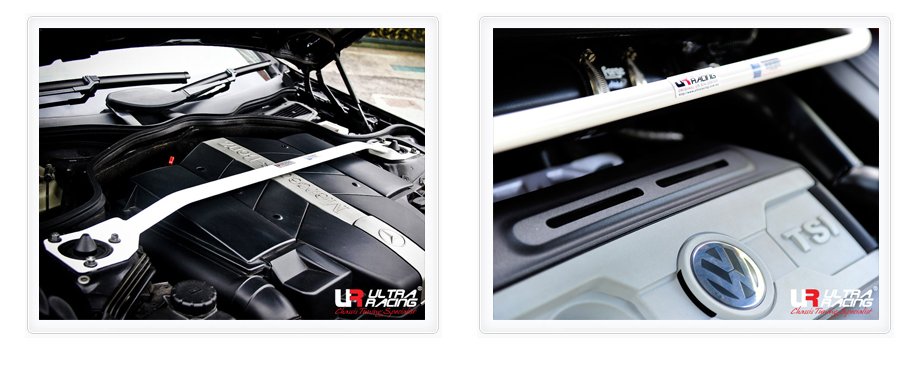Mounted at the front chassis for strengthening purposes. To eliminate all the suspension noise and more stability during acceleration, hard driving and braking (simulating race track conditions).
Every vehicle's front chassis is different therefore designs and develops the front bars based on the actual conditions of the vehicle, repeatedly testing and proving to its perfection. High attention is taken during the design and development stage to ensure the chassis is able to withstand the load when a bar is being installed.
If you're serious about your car's handling performance, you will first be looking at lowering the suspension. In most cases, unless you're a complete petrolhead, this will be more than adequate. However, if you are a keen driver, you will be able to get far better handling out of your car by fitting a couple of other accessories to it. The first thing you should look at is a strut brace. When you corner, the whole car's chassis is twisting slightly. In the front (and perhaps at the back, but not so often) the suspension pillars will be moving relative to each other because there's no direct physical link between them. They are connected via the car body, which can flex depending on its stiffness. A strut brace bolts across the top of the engine to the tops of the two suspension posts and makes that direct physical contact. The result is that the whole front suspension setup becomes a lot more rigid and there will be virtually no movement relative to each side. In effect, you're adding the fourth side to the open box created by the subframe and the two s...
Read more [+]Mounted at the front chassis for strengthening purposes. To eliminate all the suspension noise and more stability during acceleration, hard driving and braking (simulating race track conditions).
Every vehicle's front chassis is different therefore designs and develops the front bars based on the actual conditions of the vehicle, repeatedly testing and proving to its perfection. High attention is taken during the design and development stage to ensure the chassis is able to withstand the load when a bar is being installed.
If you're serious about your car's handling performance, you will first be looking at lowering the suspension. In most cases, unless you're a complete petrolhead, this will be more than adequate. However, if you are a keen driver, you will be able to get far better handling out of your car by fitting a couple of other accessories to it. The first thing you should look at is a strut brace. When you corner, the whole car's chassis is twisting slightly. In the front (and perhaps at the back, but not so often) the suspension pillars will be moving relative to each other because there's no direct physical link between them. They are connected via the car body, which can flex depending on its stiffness. A strut brace bolts across the top of the engine to the tops of the two suspension posts and makes that direct physical contact. The result is that the whole front suspension setup becomes a lot more rigid and there will be virtually no movement relative to each side. In effect, you're adding the fourth side to the open box created by the subframe and the two suspension pillars.
Is there a need to have the vehicle chassis strengthened?The chassis of the car is the part which experiences the most of the abuse from the driver. It is particularly due to the weight transfer of the vehicle body during fast cornering, hard braking or hard acceleration. In some instances, the weight transfer during cornering may cause one side of the vehicle to experience as much as 3 times more force than the other side of the vehicle, causing enormous chassis flex/ vehicle body deformity and twist, consequently causing tires to lose grip. Deformity and twisting of the vehicle chassis during cornering may cause negative handling traits such as understeering and oversteering.

For more information, please click:
https://www.e-revmotorsports.com/index.php?route=product/ecatalog&path=62
Read less [-]











